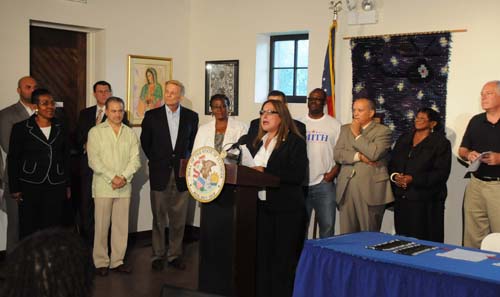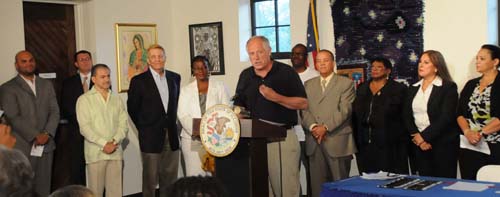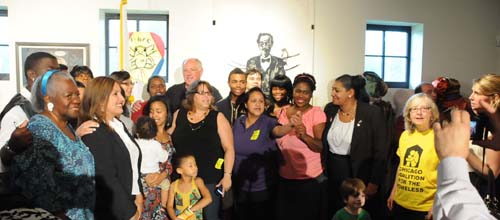Chicago school facilities bill becomes law... Struggle now to force Chicago Board of Education to follow the law in school building and repair decisions
Surrounded by political leaders, community organizations, parents, students, and union representatives who worked for nearly three years to create a law telling Chicago's public school officials how to make decisions on school closings, consolidations, repairs, and construction, Illinois Governor Pat Quinn signed the Chicago Facilities Bill (formerly Illinois Senate Bill 630) into law on August 20, 2011. The signing took place at the Museum of Puerto Rican Culture in Chicago's Humboldt Park.
 State Rep. Cynthia Soto (above at podium) took time during the signing ceremony for SB 630 (now a state law) to thank the dozens of people and organizations that devoted nearly three years to bringing the law from an idea to the August 20, 2011 signing by Illinois Governor Pat Quinn (far right in background above). Rep. Soto originated the bill in response to the Chicago's Board of Education's attacks on schools in her district, including Carpenter and Andersen elementary schools, which were destroyed by Chicago's "Renaissance 2010" program. Substance photo by George N. Schmidt.The signing of the law culminated years of struggle across Chicago by community activists in the face of the program called "Renaissance 2010" initiated by the Civic Committee of the Commercial Club and former Mayor Richard M. Daley. By February 2009, when the proposed legislation was first announced by Rep. Cynthia Soto, the Chicago Board of Education had been closing and privatizing public schools for more than five years. At the time Rep. Soto proposed the legislation, the hope was that it would freeze school changes for 2009, but the Chicago Board of Education thwarted that hope and continued its policy of destroying neighborhood schools based on various pretexts, including closing, consolidation, phase out, turnaround, and whatever other term they could use to describe the process of undermining the public schools, usually to privative the facilities or promote residential gentrification at the expense of established communities.
State Rep. Cynthia Soto (above at podium) took time during the signing ceremony for SB 630 (now a state law) to thank the dozens of people and organizations that devoted nearly three years to bringing the law from an idea to the August 20, 2011 signing by Illinois Governor Pat Quinn (far right in background above). Rep. Soto originated the bill in response to the Chicago's Board of Education's attacks on schools in her district, including Carpenter and Andersen elementary schools, which were destroyed by Chicago's "Renaissance 2010" program. Substance photo by George N. Schmidt.The signing of the law culminated years of struggle across Chicago by community activists in the face of the program called "Renaissance 2010" initiated by the Civic Committee of the Commercial Club and former Mayor Richard M. Daley. By February 2009, when the proposed legislation was first announced by Rep. Cynthia Soto, the Chicago Board of Education had been closing and privatizing public schools for more than five years. At the time Rep. Soto proposed the legislation, the hope was that it would freeze school changes for 2009, but the Chicago Board of Education thwarted that hope and continued its policy of destroying neighborhood schools based on various pretexts, including closing, consolidation, phase out, turnaround, and whatever other term they could use to describe the process of undermining the public schools, usually to privative the facilities or promote residential gentrification at the expense of established communities.
Although political leaders had come out against the closings in prior years, a larger group was galvanized in protest in January and February 2009 thanks in part to the work of teachers who had created CORE (the caucus of rank-and-file educators) within the Chicago Teachers Union a year earlier. CORE's original tee shirts stated the group's opposition to Renaissance 2010 and Mayor Daley's ongoing privatization programs. (See related article in Substance).
 Prior to the signing of the law, Illinois Governor Pat Quinn and the law's two major legislative sponsors, Rep. Cynthia Soto and Senator Iris Martinez (above, far right) thanked the dozens of people who make the law possible, from the initial work in drafting the legislation in 2009 through the hearings by the task force in 2010 and into 2011, until the final push to get the law passed by both houses of the General Assembly in 2011 despite opposition from Chicago Mayor Rahm Emanuel. Substance photo by George N. Schmidt.The legislation signed by Governor Quinn on August 20, 2011, requires that the Chicago Board of Education go through a public and transparent process in order to do school facilities decisions. The process includes the publication of a list of all facilities data on all schools and community hearings whenever the Board of Education contemplates radical changes in schools.
Prior to the signing of the law, Illinois Governor Pat Quinn and the law's two major legislative sponsors, Rep. Cynthia Soto and Senator Iris Martinez (above, far right) thanked the dozens of people who make the law possible, from the initial work in drafting the legislation in 2009 through the hearings by the task force in 2010 and into 2011, until the final push to get the law passed by both houses of the General Assembly in 2011 despite opposition from Chicago Mayor Rahm Emanuel. Substance photo by George N. Schmidt.The legislation signed by Governor Quinn on August 20, 2011, requires that the Chicago Board of Education go through a public and transparent process in order to do school facilities decisions. The process includes the publication of a list of all facilities data on all schools and community hearings whenever the Board of Education contemplates radical changes in schools.
 After the signing, Governor Quinn posed with some of the members of the community and students groups who provided input during the year-long hearings by the Task Force established by the proposed legislation. Among those in the photo above are representatives of Blocks Together, the Grand Boulevard Federation, the Chicago Teachers Union, the Chicago Coalition for the Homeless, and Designs for Change. Substance photo by George N. Schmidt.One of the early parts of the process that led to the law was the establishment of a Task Force which held public hearings.
After the signing, Governor Quinn posed with some of the members of the community and students groups who provided input during the year-long hearings by the Task Force established by the proposed legislation. Among those in the photo above are representatives of Blocks Together, the Grand Boulevard Federation, the Chicago Teachers Union, the Chicago Coalition for the Homeless, and Designs for Change. Substance photo by George N. Schmidt.One of the early parts of the process that led to the law was the establishment of a Task Force which held public hearings.
THE FINAL EDITED VERSION OF THIS SUBSTANCE STORY WILL BE PUBLISHED BY MIDNGIHT AUGUST 21, 2011.

